Vegetable selection
Fruitless vegetables can be grown without soil: tomatoes, cucumbers, bitter gourds, strawberries, and cherry radishes. Leaf vegetables include lettuce, celery, coriander, cabbage, canola, spinach, and Artemisia. The maturity of these dishes varies. Fruit vegetables generally 3-5 months, leafy vegetables generally 2-3 months. The temperature of fruits and vegetables is required to be around 10-25 degrees, and all day long, the demand for leafy vegetables is relatively small, and the average family is suitable for planting. All agricultural institutes and seed companies have sales of vegetable seeds.
Appliance preparation
Discarded plastic cups with holes at the bottom of the cup for nursery use. Plastic pots or foam boxes (bottom with holes) with trays at the bottom. Do not use pots. 0.5 kilograms of terra cotta and 1-2 kilograms of perlite (available at the building materials store), vermiculite, peat, and rock wool are available. The concentrated nutrient solution is divided into two types, No. 1 and No. 2, which must be diluted and used together. Empty plastic can bottle 2 (diluted nutrient solution).
Nursery
Invasion. Seeds must be soaked in 32-degree warm water for 6 hours. Soak the substrate. The boulder and perlite are soaked in water for use. sowing. Seedlings filled with plastic soaked in a good matrix, finger digging, fruit and vegetable seeds per hole 2 seeds, leaf vegetables dig ditch, Shun small ditch sow. After being covered with a substrate, lightly press and cover with a plastic bag or film to wait for emergence.
management
Casting. After emergence, dilute the nutrient solution 1-2 times a day, and it is advisable to extrude the liquid in the tray. Vegetable seedlings. When the young seedlings grow two leaves, the seedlings begin to sparse. Only one seedling is left per hole, and the excess seedlings are unplugged. Change basin. When the seedlings grow to have 3-5 true leaves, they will have to change big pots. A layer of immersed terra cotta was laid on the bottom of the pot to facilitate drainage, and then the perlite was spread. The small seedlings were transplanted into the pot with the substrate, and finally a layer of terra cotta was placed on the perlite. For a good pot after the pouring, the first time to drench, with the tray to seep out. Casting. The leafy vegetable was poured 2 times a day. The water was poured 2 times a day. The fruit and vegetables were not watered but only poured 2 times a day.
We may have heard of the Zoom Bullet Camera, so what is the Zoom Bullet Camera/ Bullet Zoom Security Cameras/ Bullet Zoom Digital Cameras/ Smart Zoom Bullet Camera/ Zoom Lens Bullet Cameras/ Zoom Bullet Camera HD? We know that the Bullet refers to the camera shape, so what about the Zoom? Actually, the Zoom refers to a type of the camera lens. Today let me introduce the camera lens for you.
I have introduced the camera lens and 2 classifications for you before. Today please let me introduce another parameter of the camera lens for you---the Wide Dynamic.
So what is the Wide Dynamic?
The Wide Dynamic actually refers to the brightness ratio of the brightest and darkest parts of the image that the user can see at the same time via the camera. The Dynamic Range broadly refers to the changing span of a changing thing, that is, the range from the lowest point and the highest point of its changing value, which is usually described as the difference between the highest point and the lowest point. Well, the Ddynamic Range of a camera refers to the ability of the camera to adapt to the light reflection of the scene in the shooting scene, specifically the range of brightness (contrast) and color temperature (contrast); which means the camera's adjustment range of the "darkest" and "brightest" of the image, or the ratio of the lightest tone to the darkest tone in a still image/video frame. And the hue can show the precise details in the image or frame. As the ratio of the two tones, the unit of the dynamic range can be decibels, bits, files, or simply expressed as a ratio or multiple.
The Wide Dynamic Camera Technology is a technique by which the user can see the characteristics of the image under very strong contrast via the camera. In some occasions where the contrast between light and dark is too large, due to the limitation of the CCD's photosensitive characteristics, the background of the captured images will be easily too bright/the foreground of the captured images will be easily too dark. Later, Because of the wide dynamic technology emerged, and this problem has been solved.
So how about the applications of the Wide Dynamic Camera?
The Wide Dynamic camera is usually applied when the light environment is still ideal but the details of the target object cannot be obtained. That is to say, the wide dynamic technology is mostly used in places where light and dark alternate. When the surveillance camera cannot achieve low-illuminance monitoring, the wide dynamic technology needs to be used to "fill the light". In terms of the surveillance camera applications, the ordinary surveillance camera captures the images with the clear background but the dark foreground, while the wide dynamic camera can capture the images with both the clear foreground and background.
The Wide Dynamic Camera is usually applied to the Highway toll system, the Electronic police system, the City Commercial Street and so on; which is very useful and has brought much convenice to our life.
In a word, I hope that the introducton of the Wide Dynamic can make all of us know more about the Zoom Bullet Camera and the whole video monitoring field.

Zoom Bullet Camera, Bullet Zoom Security Cameras, Bullet Zoom Digital Cameras, Smart Zoom Bullet Camera, Zoom Lens Bullet Cameras, Zoom Bullet Camera HD​
SHENZHEN SANAN TECHNOLOGY CO.,LTD , https://www.sanan-cctv.com